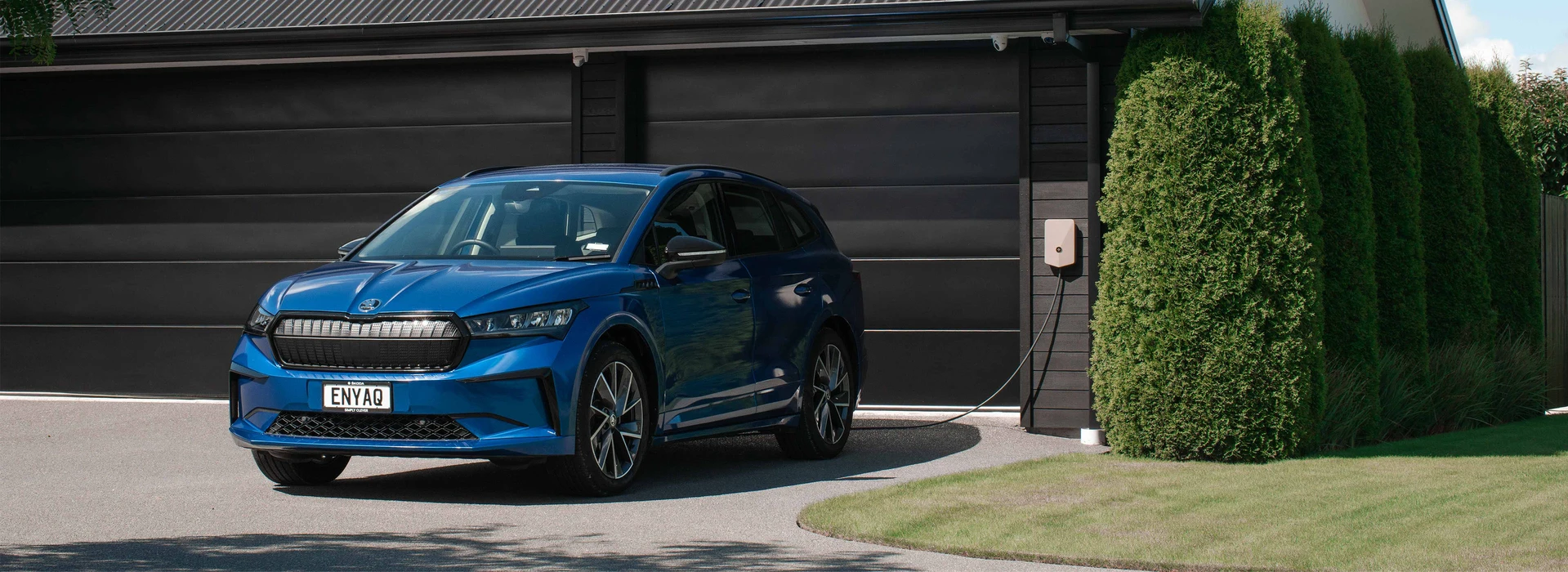Home charging for added flexibility
Charging at home gives you the flexibility of topping up your battery when you are not using your car. Often this means plugging in overnight and waking to a fully charged battery ready for your next journey. Similar to how you use your mobile phone.
Home Charging: A step-by-step guide
1. Choose your charging method
All home charging uses AC current but the speed at which you can charge will be impacted by the method you choose. If you plan to regularly charge at home we recommend having a home charger installed to ensure that your charging is as quick as possible.
2. Connect the cable
Home chargers can either be tethered, a cable attached to the unit, or un-tethered where you use the mode 3 cable which comes as standard with your Škoda iV models. Either way the cable should be attached to the charging unit and also to the vehicle.
3. Let the car charge
A green LED light will start to flash to let you know the car is charging. Once you lock your Škoda the charger will lock in place. When the light stops flashing and lights green solidly, the vehicle is fully charged. You don’t need to fully charge your vehicle every time, if you only have time for a quick top up then do what works best for you and your upcoming journeys.
4. Track the charge level
You can see how much your car has charged via the EVNEX mobile app. The app tells you both the charge level, how quickly your car is charging and at what rate and estimates how much longer it will take for your car to be fully charged.
AC and DC charging explained
Alternating current (AC) charging is the type of current currently provided by the National Grid. Because of this it’s the most common type of charging found in the public charger infrastructure. AC charging requires a Type 2 plug, which is the same as the plugs you have at home, and a Type 2 charging cable is provided with all our electric vehicles.
Direct current (DC) charging uses a higher voltage and is therefore faster. It’s only available at specialised charging stations usually found on motorways and in car parks at large retailers. All DC chargers are tethered, and your car will need a specialised Combined Charging System (CCS) to take advantage of them.
Home Charging methods explained
3-pin plug or domestic charger
This method of charging is much like plugging in your computer or mobile phone. It uses a 3-pin plug at the end of a charging cable and can therefore be plugged into a standard domestic wall socket. This method of charging is the slowest way to charge your electric vehicle, so we recommend it is mainly for occasional use.
Home EV smart charger
A home smart EV charger can increase your rate of charge by up to 3 times vs using a domestic 3 pin plug. It is specifically installed for the sole purchase of charging your electric vehicle and can make a very convenient solution for topping up your vehicle when you are not using it.
The future of home charging - Evnex
Charging your car at home is as easy as charging your phone. Our preferred home charging partner is Evnex, a leading New Zealand manufacturer and installer of smart EV chargers who will provide a seamless charging experience for all Škoda electric vehicles.
Evnex smart EV chargers are engineered in New Zealand—so you can count on a locally-based team of Kiwis with a can-do attitude and inventive spirit.
Enjoy freedom with a fast and affordable EV charge, from Evnex. Request an installation quote today to get set up to charge at home.
Home charging FAQs
It is always best to check with your chosen smart EV charger supplier whether your property can have a home charger installed. Our preferred home charging partner is Evnex, a leading New Zealand manufacturer and installer of smart EV chargers. The home charger offers leading features such as smart scheduling, intelligent charging & solar optimisation.
Installation of electrical equipment, such as a smart EV charger, in your home should always be carried out by a qualified professional.
This will depend on many factors, for example: how regularly you are charging your vehicle; the amount of charge you put into your vehicle with each charge; the size of your battery; and the amount your energy provider charges you per kWh.
Charging your EV at home is the most cost-effective way to recharge.
Kilowatt (kW) refers to the power rating of a home charge point and is the maximum amount of power that can be drawn from the socket at any one time. A 7kW home charger will charge your car three times faster than a three-pin plug.
This is really down to personal choice and may often be dependent on what journeys you have planned for the next day and how much mileage you need to cover. Some EV drivers choose to plug in every night to ensure they always set off with a full battery, others choose to charge once or twice a week to suit their range needs.
